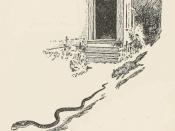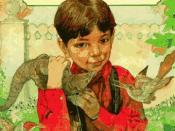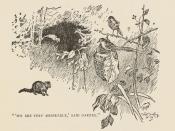The animals in Rudyard Kipling"s masterpiece short story "Rikki - Tikki - Tavi" utilize rational thinking in order to pursue their objectives. First, Rikki, a mongoose, applies logical thinking to protect his human friend Teddy and his family. Next, Darzee's wife outsmarts Nagaina, the evil snake. Finally, Nagaina employs judicious reasoning in order to try to kill Rikki-Tiki-Tavi's human friends and save her eggs. In conclusion, these animals think like human beings in order to achieve their goals.
First of all, Rikki defends his human friends by rationalizing like a human. Rikki overhears Nagaina's husband Nag saying that he is going to kill the human family. Rikki knows in order to save the family, he must kill the snake. He says, " If I don't break his back at the first jump, he can still fight. It must be the head, the head above the hood. And, when I am once there, I must not let go" (394).
Cobras are tough creatures to fight. Rikki fathoms that he can not overpower the snake. He must paralyze the cobra. He reasons that the only place to attack the snake is in the head. Otherwise, the cobra would still be able to fight. Another example of how Rikki uses logical thinking is when he kills the cobra's eggs. He says, " He could see the baby cobras curled up inside the skin, and he knew the minute they were hatched they could kill a man. He bit off the top of the eggs, taking care to crush the young cobras"(396). Even though baby cobras are inferior in size to adult cobras, their bite is just as powerful and deadly. If hatched, these baby snakes pose a legitimate threat to the humans. Rikki infers that the only way to prevent the...


